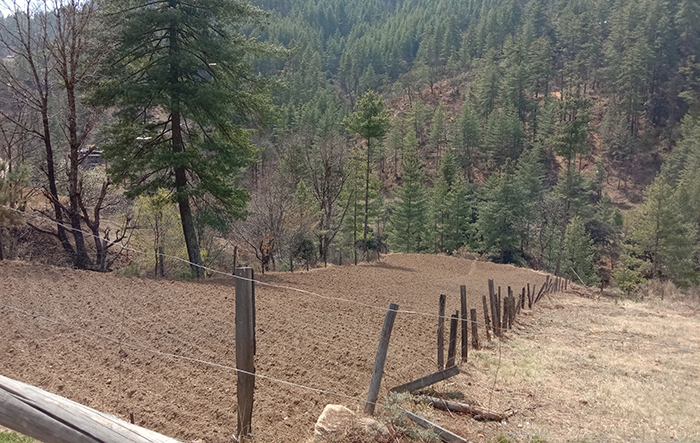Choki Wangmo
Kezang Yangchen, 53, has a three-acre land in Kushuchen, far up north from Thimphu city. So, she always had to contend with the growing instances of human-wildlife conflict.
Were it not for electric fencing she would have had to leave her land fallow. And then she noticed something stark. The community forest was losing trees at a worrying rate.
Three years ago, Kezang Yangchen had to fell 300-something trees for electric fencing. They have now begun to rot and need replacement.
“If the poles are damaged, the fencing becomes ineffective,” said Kezang Yangchen. But she isn’t looking to cut down trees from the community forest.
What options does she have, though? If seven households cut down 300 trees every three years for electric fencing, that would mean a loss of 21,000 trees from the community forest.
An official from National Plant Protection Centre, Nidup Dorji, said that although acreage differed depending on the shape of field, usually there are 13-15 acres per kilometre (km). That means, if a pole distance is 2.5 metre, 400 poles would be required per km.
According to records with the agriculture ministry, between 2009 and 2018, a total of 3,492km of electric fences was established to protect 39,346 acres of agricultural land across the country. About 1.6 million wooden poles were used—145,371.96m3 of forest harvest for construction of electric fence.
About 400 hectares of forest has already been harvested in a period of nine years to address human-wildlife conflict. On an average, there is an annual demand of 10,000-12,000 wooden posts for fencing in every chiwog.
If the trend continues, the reserved forests could face serious sustainability challenges.
To reduce pressure on forest resources, a study carried out in Mongar discussed the use of High Density Polyethylene (HDPE) for electric fencing. However, It concluded that the cost of HDPE pipe was three times higher than that of wooden poles. “The initial investment cost should be subsidised or borne by the government or else most Bhutanese farmers would not be able to benefit from HDPE.”
The cost difference was attributed to the higher cost involved in purchase of HDPE poles from Bhutan Polyethylene Company compared to the minimal cost involved in acquiring wooden poles from nearby forests.
But the long-term benefit of opting for HDPE pole could save about 41.63m3 of forest volume per km which could produce Nu 42,448 worth of ecological services for the country.
It was also found that HDPE pipe has a minimum service life span of 50 years, 100 years if corrugated.
Considering 41.63m3 of forest is harvested in constructing 1km fence, the study found that a km of electric fence would save 41.63 m3 of forest by switching to HDPE poles.
The research, however, did not evaluate the carbon footprint of producing HDPE poles.
Last year, Greener Way ventured into producing plastic poles suitable for electric fencing which is expected to last for 15 years. Depending on the shape and size of the poles, 3-12kg of plastic waste is used in producing a single pole.


